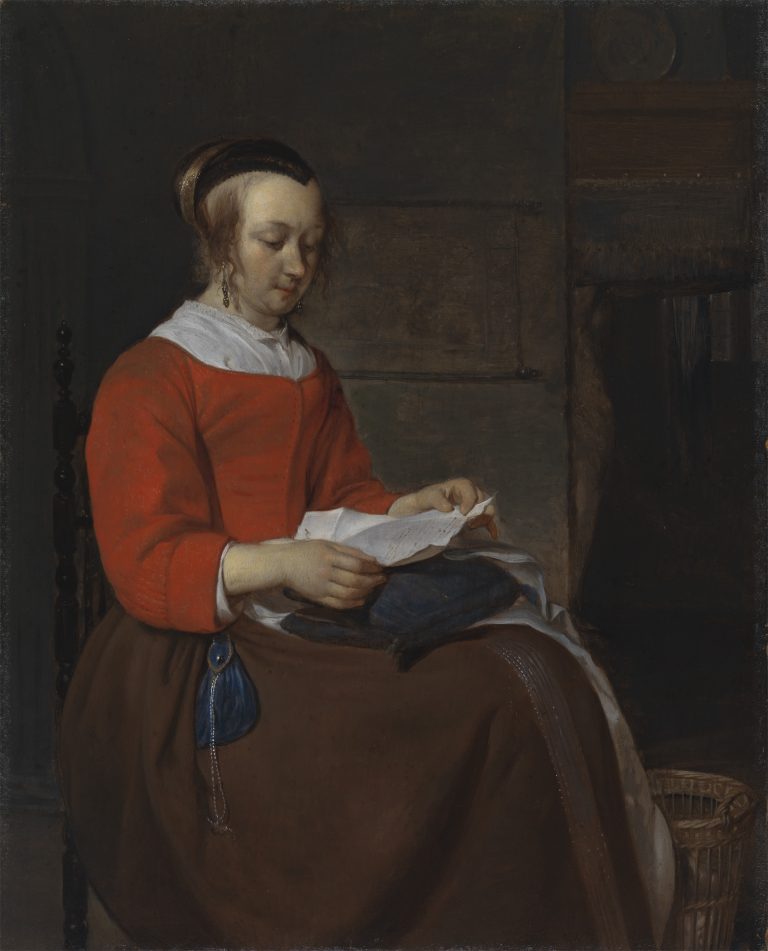Gabriel Metsu was a master at rendering the sense of expectation and anticipation that occurs when one reads a letter from a loved one. Here, a young woman, sitting demurely near her sewing basket and with a sewing cushion on her lap, looks down to read the letter that has arrived while she was diligently engaged in her needlework. The scene is quiet and still, with the only semblance of movement being the slight smile that crosses her face as she reads her lover’s missive. Although not privy to the text, the viewer is a silent witness to this tender and private moment.
Metsu, who was always keen to respond to contemporary trends in Dutch genre painting, was an avid painter of scenes of amorous correspondence, a popular theme for artists painting during the third quarter of the seventeenth century. The appeal of these works reflects the important role of letter writing in the Netherlands. The ability to compose eloquent messages was an indication of civility and education, even if the writer made use of the letter-writing manuals that were widely available in the Dutch Republic.1 The subject allowed artists to create engaging images of men and women either reading a billet-doux from a lover or searching for words to express their own feelings on paper.
Metsu made no fewer than nine images of men or women reading or writing love letters from the late 1650s to the mid-1660s.2 Young Woman Seated in an Interior, Reading a Letter is the earliest of the three representations of a female letter reader he made during this period. He executed it around 1658–61, just as he began shifting his attention from working maids to elegant women engaged in leisurely pastimes.3 The young woman’s clothes, earrings and silver ear picker (an ornamented tool to clean the ear canal) hanging on a chain attached to a blue velvet purse clearly associate her with the middle class.
Metsu’s approach to this subject owes much to the paintings of pensive women writing and reading letters that Gerard ter Borch (1617–81) made in the mid-1650s. Indeed, Ter Borch may be credited with inspiring not only Metsu’s interest in depicting the theme of amorous correspondence, but also that of Pieter de Hooch (1629–84), Frans van Mieris (1635–81), Johannes Vermeer (1632–75), and Caspar Netscher (ca. 1639–84).
Two of Ter Borch’s paintings in particular, A Woman Writing a Letter from ca. 1655–56 (fig 1) and A Woman with a Wine Glass Reading a Letter (fig 2) from about one to two years later, seem to have inspired Metsu when making this work.4 Ter Borch situated the women in these paintings seated close to the picture plane and placed them against a dark background. Metsu freely adapted these compositional features in making this painting, but in doing so he created an image more tranquil and intimate than those created by Ter Borch, partly by painting his scene in a smaller format and placing his figure nearer the front of the picture plane. Whereas Ter Borch incorporated two to three areas of color to enliven his scenes—the women’s clothes, the carpets on the tables, and the upholstery of a chair—Metsu limited his bright color—the red of the bodice—to the woman herself.5
Ter Borch often used his half-sister Gesina (1631–90) as a model for his genre scenes and, in a similar fashion, Metsu frequently painted his own wife, Isabella de Wolff, in domestic roles, as he did here. Though Metsu did not portray her accurately in all of these scenes, her facial features are generally recognizable even if her appearance varies from one work to the next.6 When Metsu painted this work, Isabella had been his wife only briefly: the couple had married in Enkhuizen in May 1658. Isabella was the daughter of Wouter Coenraetsz de Wolff and Maria de Grebber (1602–80), one of Holland’s few female artists.7
